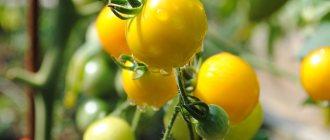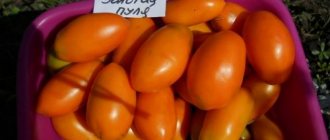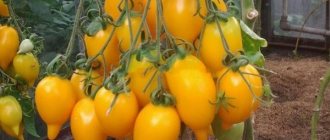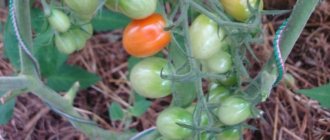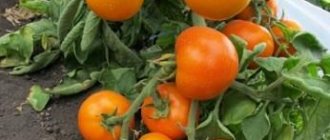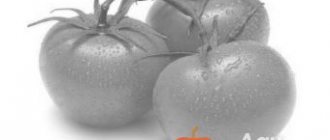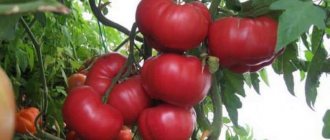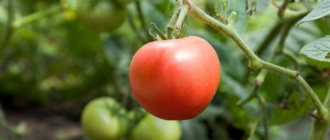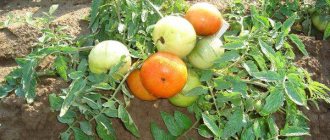Description of the tomato variety Golden Andromeda with photo
Recommended for cultivation in the Central and North Caucasus regions of Russia. “Golden Andromeda” is a first-generation hybrid, bred by artificial pollination of several different varieties.
A plant with a well-developed root system. "Golden Andromeda" is a determinate type tomato, which is associated with limited growth.
Bush height – 60-70 cm
The plant is highly branched, semi-spreading, with a large number of dark green leaves. They are alternate, pinnately dissected, and consist of several lobes. Their surface has a small amount of villi. Leaves with smooth blades are less common.
Important! When forming fruits, it is recommended to tie the plant to a trellis so as not to damage the stems.
Flowering occurs 80-90 days after sowing the seeds. An ovary appears in the upper part of the bush, consisting of several buds. Each consists of 5-6 long pointed petals.
Description of fruits
Ripe tomatoes are round in shape. The ribbing is absent or very weak. The skin is glossy, durable, without stains. In the photo of an early ripening tomato “Golden Andromeda F1” it is noticeable that the fruits are bright orange. Until they ripen, they are light green.
Average weight of “Golden Andromeda” tomato – 110 g
Average weight of “Golden Andromeda” tomato – 110 g
Large specimens can reach 300 g. Moreover, the fruits do not have empty space inside, and their flesh is dense and hard.
Important! Golden Andromeda tomatoes contain up to 2.8% sugar.
The variety is characterized by good taste. Fresh fruits are moderately juicy, sweet and sour, each with 4-5 seed chambers.
Tomatoes "Golden Andromeda" are distinguished by their high shelf life. They tolerate transportation well and are not damaged by minor mechanical stress.
Fruit characteristics
Summer residents note the high yield of Andromeda tomato. The bushes bear fruit every summer in late August and September. The average weight of yellow tomatoes can be 350 g. Up to 10 kg of vegetables are harvested from an area of 1 m². The average weight of pink and red fruits is 125 g. They are slightly smaller in size, but there are more of them on the bush. Up to 9 kg of tomatoes are harvested from an area of 1 m².
Fruit characteristics
The fruits on the plants ripen evenly in clusters. They are used fresh and for canning.
How are tomatoes stored?
Remove the tomatoes as soon as they turn red. There is no need to overcook them, otherwise the skin will begin to crack. They are then stored in a dark, cool basement at a temperature of about 7 ºC, where the tomatoes can not spoil for more than 4 weeks. To do this, fruits are selected without dark spots and placed in one layer in boxes with sawdust. When the first signs of rot appear, such a tomato is immediately removed. For better storage, tomatoes are picked along with the stalks.
Growing this vegetable crop does not require much effort, however, even before purchasing seeds, you need to carefully study the description of the Andromeda tomato and its distinctive features. This will help avoid many mistakes in the future.
Characteristics of tomato Golden Andromeda
The variety has moderate resistance to cold. The bushes normally tolerate sudden changes in temperature and adverse weather conditions. Therefore, they can be planted in open ground in early spring.
"Golden Andromeda" is a drought-resistant hybrid. However, to obtain a bountiful harvest, the bushes are watered regularly.
The variety is undemanding to the content of nutrients in the soil. Tomato grows well after legumes and other nightshade crops.
Golden Andromeda tomato yield and fruiting
The variety is characterized by stable and long-lasting fruiting. From 1 sq. m. 7-8 kg of tomatoes are collected.
Ripening period – up to 110 days
The Golden Andromeda variety is well suited for growing in greenhouses due to its compact size. The bushes can be placed at a short distance, and thereby increase the number of collected fruits.
Yields are affected by:
- seed quality;
- compliance with seedling growing techniques;
- climatic features of the region;
- fertilizing;
- quality of care.
In open ground the yield is lower. Plants in areas are more often affected by diseases and pests.
Area of application of fruits
The variety is considered universal. Tomatoes “Golden Andromeda” are recommended to be consumed fresh.
They are also used for making salads, pickling and pickling. The fruits are used to make juices, dressings and sauces.
Resistance to diseases and pests
The variety is sensitive to many infections. Moderate resistance is manifested only to tobacco mosaic virus and macrosporiosis.
Late blight is considered the most dangerous disease of the Golden Andromeda variety.
Stem necrosis and gray rot can cause significant damage to bushes. In case of such diseases, the plant must be removed from the soil to prevent the spread of infection.
The variety is not resistant to pests. The greatest danger is posed by the larvae of the cockchafer, mole crickets and cutworm caterpillars. Spider mites also often appear on bushes.
Tomato storage
The first brush of a tomato is placed above the fifth leaf, then flowers are formed after 1-2 leaves. Intermediate brushes form many flowers. Each bunch can produce up to 8-10 marketable tomatoes. For this purpose, the inflorescences are treated with fruit formation stimulants. During normal cultivation, no more than 6 fruits are laid on a tassel. With proper agricultural technology, up to 3 kg can be harvested from one plant. With normal care, up to 5 kg can be obtained per square meter of plantings.
Mass collection is carried out 2-2.5 months after planting the seedlings. It is better to pick the fruits at ripeness. This improves the conditions for the formation and ripening of the remaining tomatoes. They try to pick the fruits from the brush without the stalk. In summer, collections are carried out daily, in autumn every 2 days.
Yellow Andromeda tomatoes are very tasty when eaten fresh, suitable for processing into juice, whole-fruit pickling, and for canning in the form of salads, including lecho.
The tomato belongs to the keeping varieties. It is stored for 2-3 months if the room temperature is kept at 1-3 degrees. To keep tomatoes longer, they are placed in wooden boxes in 1-2 layers. Fruits that have begun to ripen are immediately removed from the boxes, as they emit ethylene gas, which accelerates the ripening of nearby fruits. Tomatoes are stored only in green and brown form.
Medium early / Medium height
User rating: 5/5
Mid-season / Mid-season
User rating: 4/5
Early maturing / Medium growing
The early-ripening hybrid produces a harvest 90 days after sowing the seeds. The ripening of the fruits is uniform, in whole clusters, which greatly simplifies the collection.
The use of vegetables is universal: they are used to make summer salads, hot and vegetable dishes, mousses, various snacks, pizzas, and freshly squeezed juice. Small tomatoes retain their flavor well in whole-fruit canning, marinades and pickles. Tomatoes go well with dill, horseradish, eggplant and meat. Ripe vegetables make delicious juices, lecho, adjika, and ketchup.
Ripe vegetables retain their presentation for 4 months if stored in a cool place. They can be transported over long distances to any location; the dense peel protects the vegetables from cracking.
Tomato Andromeda F1 reviews, photos, yield, characteristics and description of the variety, which are presented in this article, is considered one of the best varieties with early ripening.
It is suitable for cultivation in warm and cold regions. The Andromeda tomato variety has three varieties that differ in color: red, yellow, pink.
The variety produces a consistently good harvest, and the tomatoes have excellent taste.
Effective, convenient and sooooo fast. When you need to lose 3-4 kilograms in a week. Read more here...
Further in the article you will learn the full characteristics of the variety and fruits, the advantages and disadvantages of Andromeda tomatoes and the features of growing them through seedlings. At the end of the article, reviews are offered from gardeners who have already grown this variety on their plots and shared their opinions.
The Andromeda F1 variety was bred in 1998 by Russian breeder A.A. Mashtakov. Among the 3 varieties of these tomatoes, the Pink Andromeda tomato has the earliest ripening period. The second subspecies is Golden Andromeda, which has large yellow fruits.
- Hybrid, as the name suggests, the F1 additive.
- The Andromeda tomato variety is suitable for cultivation in greenhouses and open ground.
- Early. The first ripe tomatoes can be collected from the bushes 92-115 days after the seeds germinate. Golden Andromeda tomatoes ripen in 104-112 days. Pink tomatoes ripen in 78-88 days. You can expect tomatoes after the described time if the weather conditions are favorable. If the weather is cold and rainy, then the fruits will ripen 4-12 days later. This time is enough for the plants to get stronger and grow well, and for them to bear the first fruits of commercial ripeness.
- Determinate type of bush; in open ground the plant grows up to 75 cm in height. In the greenhouse, the bushes stretch up to 1 m. The stems must be tied to a support or trellis.
- Not standard, has medium branching. In the pink Andromeda subspecies, ordinary silver-emerald-colored leaves are formed on the bushes. The remaining subspecies develop leaves of lighter colors. The leaves are medium sized and slightly corrugated. Pedicel with articulation.
- Bushes are best formed into 1 or 2 stems. When forming into 2 stems, a stepson is left under the first inflorescence. The rest are removed, leaving a stump of 5-7 mm so as not to damage the main stem. This is necessary to ensure that yields remain high.
- A simple flower brush is formed over the 6th leaf, followed by 1-2 leaves. 5-6 tomatoes are tied on one brush.
- Productivity is high, Golden Andromeda brings 8.5-10 kg per sq.m., Pink is slightly less - 6-9 kg per sq.m.
- The plant is not resistant to late blight, so it is necessary to take preventive measures and adhere to the rules of agricultural technology.
- Poorly developed root system.
- The plant requires feeding during growth and fruit formation.
- It is unpretentious in care and tolerates temperature changes well.
Emaciated Stepanenko: I weighed 108, and now 65. At night I drank warm... Read more here...
Varieties
The harvest is harvested in the last ten days of August - early September. “Andromeda Red” yields 9-10 kg per 1 sq.m of bed, “Pink” – 6-9 kg.
The variety is oriented for cultivation in the Central Black Earth Region. The average yield in this region ranges from 130 to 500 centners per hectare. However, “Andromeda” is successfully grown in the Yaroslavl and Vladimir regions and throughout Russia.
Advantages and disadvantages
The variety is high-yielding and unpretentious in care. Therefore, they are widespread among vegetable growers.
Ripe “Golden Andromeda” tomatoes do not crack and retain their presentation for a long time
pros
- high productivity;
- presentation of the fruit;
- good taste;
- resistance to certain diseases;
- does not require stepsoning;
- high transportability;
- resistance to cold and drought.
Minuses
- susceptibility to late blight and gray rot;
- low resistance to pests.
Features of cultivation
The description of the tomato variety “Golden Andromeda F1” with a photo indicates the need to use the seedling method. This method of cultivation is considered the most convenient, as it allows the seeds to be sown long before planting in a permanent place.
Seedlings need nutritious soil. To do this, mix garden soil with peat and sand. A small amount of compost or humus is added to the composition.
Important! If there is high acidity, add lime flour or chalk to the soil.
To sow seeds, you can use any convenient container:
- plastic glasses;
- food containers;
- flower pots;
- cut bottles;
- peat glasses.
Sowing algorithm:
- The seeds are soaked in boric acid (0.02%) for 12 hours.
- The containers are filled with soil mixture.
- Seeds are placed at a distance of 5-6 cm, without deepening into the soil.
- The planting material is sprayed from above with a spray bottle.
The variety "Golden Andromeda" has high germination rate. Sprouts emerge from approximately 85% of the seeds.
Important! Sowing of seedlings is carried out at the end of March or at the beginning of April.
The container with seeds is kept indoors at a temperature of 22-25 degrees
Picking is carried out when two true leaves appear. Each sprout is removed from the soil and planted in a separate container.
Transplantation into open ground is carried out 55-60 days after sowing. Seedlings can be transferred to the greenhouse after 40-45 days. If necessary, seedlings are hardened off in the refrigerator for 2 days.
When transplanting into open ground, plants are placed at a distance of 40 cm from each other. For 1 sq. m. it is recommended to plant no more than 5 bushes.
Subsequent care involves regular watering of the tomatoes. The bushes replenish the liquid abundantly, but rarely. In dry weather, Golden Andromeda tomatoes are watered once every 3 days. When grown in a greenhouse, the frequency of the procedure is reduced to 1 every 5-6 days.
The first feeding is carried out 1.5 months after planting in a permanent place. Apply nitrogen fertilizer. When the ovaries appear, phosphorus and potassium compounds are used, 3-4 g per bush.
Proper feeding of tomatoes:
Loosen the soil regularly. Tomatoes do not tolerate stagnant liquid, so the soil should be light. The surface layer of soil is mulched with bark, sawdust or straw during irrigation.
Diseases and pests
The Golden Andromeda tomato variety has good immunity to most diseases, but this does not exclude their occurrence.
Plants may suffer from late blight. The causative agent of this disease is fungi, which actively multiply in warm, humid weather. Brown spots form on the upper side of the leaves, and a whitish coating on the lower side. Fruits are also affected by fungi. They become spotted.
Diseases and pests
The spores overwinter in the soil and green parts of plants and appear at temperatures above 12 °C. They are especially active in mid and late summer.
Tomatoes are treated with late blight with chemicals on the underside of the leaf, because that’s where the spores are located. To combat the disease, Bordeaux mixture is used, which is sprayed once every 3 weeks. Folk remedies include ash, kefir, iodine, a solution of salt and garlic (1 glass per 10 liters of water).
Tomatoes of this variety also suffer from fusarium blight.
Fungi penetrate from the soil through small wounds and infect the root system, and then spread throughout the entire bush. The leaves of the plant wither and fall off, first near the ground, then the tomato stops blooming and bearing fruit. If the tomatoes do appear, they acquire a light yellow color.
Spores actively develop during alternating rainy and dry weather. They are carried by insects, wind and water. To prevent this disease, it is not recommended to plant tomatoes in an area where peppers, eggplants, cabbage and potatoes previously grew.
In the fight against fusarium, tomatoes are treated with a solution of potassium permanganate and boric acid, sprinkled with ash and sulfur, but during the ripening period the fruits cannot be sprayed with chemicals.
Tomatoes can also get verticillium disease. Fungi enter the plant through the soil. When they get inside, the bushes cannot receive sufficient moisture and nutrients. Soon they die.
Verticillosis is not always recognized in time. In a bush affected by the fungus, first the lower leaves wither, then the stems become wilted, and the flowers and fruits darken and die. If you make a cut on such a plant, you can see brown dots. There is no cure for verticillium.
Vegetable crops are often affected by macrosporiosis, but Andromeda tomatoes are not afraid of it.
There are several general rules that will help protect tomatoes from diseases and pests:
- In autumn, it is necessary to remove plant debris from the site. Usually it is in them that spores overwinter.
- Before planting, it is important to properly treat the soil and seeds and always observe crop rotation.
- To grow strong bushes that can resist diseases, it is important to fertilize and water on time.
The spread of spores is often facilitated by dense plantings, so plants must be pinched in time, planted at the recommended distance, and the lower leaves must be torn off.
Pest and disease control
When grown in a greenhouse or under a film cover, ventilation is carried out regularly. You can spray the bushes with fungicide 3 weeks after planting. To protect against root rot, place 1 Glyokladin tablet in the soil near each bush.
It is forbidden to spray tomatoes with preparations during fruit formation.
To protect against pests, it is recommended to treat Golden Andromeda tomatoes with an infusion of tansy or tobacco ash. Garlic water helps a lot in the fight against spider mites. To repel butterflies and caterpillars, plants are sprayed with a decoction of wormwood.
